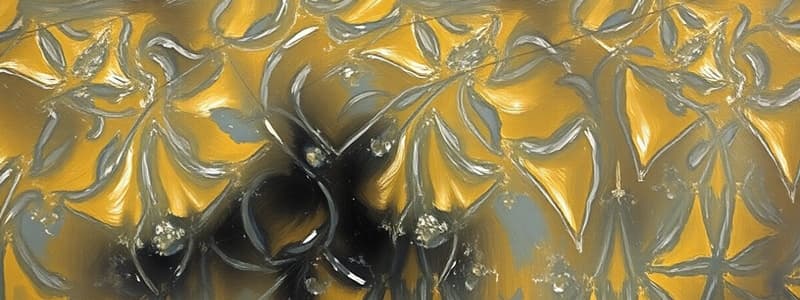Podcast
Questions and Answers
Which material property defines the ability to absorb energy in the plastic range just before fracturing?
Which material property defines the ability to absorb energy in the plastic range just before fracturing?
- Elasticity
- Modulus of toughness (correct)
- Modulus of resilience
- Strain energy
What distinguishes modulus of resilience from modulus of toughness?
What distinguishes modulus of resilience from modulus of toughness?
- Resilience applies to brittle materials, while toughness applies to ductile materials.
- Resilience indicates total energy absorption, while toughness refers to energy per unit volume.
- There is no significant difference; they are interchangeable terms.
- Resilience is the ability to absorb energy without permanent damage, while toughness includes energy absorption up to fracture. (correct)
A material is loaded and then returns to its original shape once the load is removed. Which property is primarily responsible for this behavior?
A material is loaded and then returns to its original shape once the load is removed. Which property is primarily responsible for this behavior?
- Ductility
- Stiffness
- Toughness
- Elasticity (correct)
Which of the following best describes ductility?
Which of the following best describes ductility?
If material A has a higher stiffness than material B, what does this indicate?
If material A has a higher stiffness than material B, what does this indicate?
How are stiffness and flexibility related?
How are stiffness and flexibility related?
What material property is defined as the resistance to indentation?
What material property is defined as the resistance to indentation?
What is a primary characteristic of brittle materials?
What is a primary characteristic of brittle materials?
A material has the same physical and mechanical properties in all directions. What term describes this property?
A material has the same physical and mechanical properties in all directions. What term describes this property?
What distinguishes an orthotropic material from an isotropic material?
What distinguishes an orthotropic material from an isotropic material?
What is the defining characteristic of a prismatic structural member?
What is the defining characteristic of a prismatic structural member?
A structural component under constant load slowly deforms over a long period, eventually leading to failure. Which phenomenon is this?
A structural component under constant load slowly deforms over a long period, eventually leading to failure. Which phenomenon is this?
What is the primary cause of fatigue failure in materials?
What is the primary cause of fatigue failure in materials?
Which type of structural failure is characterized by lateral deflection under axial compressive force?
Which type of structural failure is characterized by lateral deflection under axial compressive force?
What is the defining characteristic of yielding in a material?
What is the defining characteristic of yielding in a material?
What term describes the phenomenon where the cross-sectional area of a specimen begins to decrease in a localized region after ultimate stress is reached?
What term describes the phenomenon where the cross-sectional area of a specimen begins to decrease in a localized region after ultimate stress is reached?
Which of the following earthquake engineering terms describes the space between two adjacent floors of a building?
Which of the following earthquake engineering terms describes the space between two adjacent floors of a building?
What is the function of diaphragms in earthquake-resistant design?
What is the function of diaphragms in earthquake-resistant design?
What does 'story drift' refer to in structural engineering?
What does 'story drift' refer to in structural engineering?
What phenomenon is described when a building's natural period coincides with the earthquake period?
What phenomenon is described when a building's natural period coincides with the earthquake period?
Flashcards
Strain Energy
Strain Energy
Energy stored in a material due to deformation.
Modulus of Toughness
Modulus of Toughness
Maximum strain-energy a material can absorb before fracturing.
Modulus of Resilience
Modulus of Resilience
Largest amount of internal strain energy per unit volume a material can absorb without permanent damage.
Elasticity
Elasticity
Signup and view all the flashcards
Ductility
Ductility
Signup and view all the flashcards
Stiffness
Stiffness
Signup and view all the flashcards
Toughness
Toughness
Signup and view all the flashcards
Hardness
Hardness
Signup and view all the flashcards
Ductile Material
Ductile Material
Signup and view all the flashcards
Brittle Materials
Brittle Materials
Signup and view all the flashcards
Homogeneous Material
Homogeneous Material
Signup and view all the flashcards
Isotropic Material
Isotropic Material
Signup and view all the flashcards
Orthotropic Material
Orthotropic Material
Signup and view all the flashcards
Prismatic
Prismatic
Signup and view all the flashcards
Creep
Creep
Signup and view all the flashcards
Fatigue
Fatigue
Signup and view all the flashcards
Buckling
Buckling
Signup and view all the flashcards
Yielding
Yielding
Signup and view all the flashcards
Strain Hardening
Strain Hardening
Signup and view all the flashcards
Necking
Necking
Signup and view all the flashcards
Study Notes
Strength of Materials Terms
- Strain energy is the energy stored in a material due to deformation.
- Modulus of toughness indicates the maximum amount of strain-energy a material can absorb just before fracturing and reflects the ability to absorb energy in the plastic range.
- Modulus of Resilience represents the largest amount of internal strain energy per unit volume a material can absorb without permanent damage, indicating the ability to absorb energy in the elastic range.
- Elasticity is a material's property that allows it to return to its original state once the load is removed.
- Ductility refers to a material's ability to deform in the plastic range without breaking.
- Stiffness is the ability to resist deformation within the linear range, which equals the force required to produce unit deformation, where flexibility is the inverse of stiffness.
- Toughness refers to a material's resistance to fracture.
- Hardness refers to a material's resistance to indentation.
- Ductile Material is any material that can undergo large strains before fracturing.
- Brittle Materials are materials that exhibit minimal or no yielding before failure.
- Homogeneous material is a material that has consistent physical and mechanical properties throughout its volume, having the same composition at any point.
- Isotropic material has the same physical and mechanical properties in all directions.
- Orthotropic material has properties at a particular point that differ along three mutually-orthogonal axes.
- Prismatic describes a member with the same cross-sections throughout its length.
- Creep occurs when a material supporting a load for a long period continues to deform, potentially leading to sudden fracture or impaired usefulness, where this time-dependent permanent deformation is known as creep.
- Fatigue happens when a material subjected to repeated cycles of stress or strain causes its structure to break down, ultimately resulting in fracture.
- Buckling is lateral deflection occurring when long slender members are subjected to an axial compressive force.
- Yielding is a slight increase in stress above the elastic limit resulting in a breakdown of the material and causing it to deform permanently, known as plastic deformation.
- Strain Hardening refers to when, after yielding has ended, the material can support an increase in load, up to its ultimate stress.
- Necking happens right after the ultimate stress is reached, causing the cross-sectional area to decrease in a specific area, until it breaks at the fracture stress.
Earthquake Engineering Terms
- Story is the space between two adjacent floors.
- Diaphragms are rigid horizontal planes used to transfer lateral forces to vertical resisting elements.
- Shear wall is designed to resist lateral forces acting in its plane, such as wind and seismic loads, and stiffened walls can transfer lateral forces from floors and roofs to the foundation.
- Center of gravity is the point where an object experiences no torque from gravitational force.
- Center of rigidity is the center of resistance of a floor or diaphragm against lateral forces, acting as the point through which the resistance to lateral forces is applied.
- Center of mass is the point through which the resultant of the masses of a system acts, also serving as the point through which applied lateral forces act.
- Center of stiffness is the point through which the resultant of the restoring forces of a system acts.
- Eccentricity is the distance between the center of rigidity and the center of mass.
- Design seismic base shear is the total design lateral force at the base of a structure.
- Story drift is the lateral displacement of one level relative to the level above or below.
- Story displacement is the lateral displacement of the story relative to the base.
- Out-of-plane offsets are discontinuities in a lateral force path.
- Torsional shear stress is the shear stress that occurs when a structure's center of mass does not coincide with its center of rigidity.
- Resonance is the phenomenon that occurs when a building period matches the earthquake period.
- Natural period is the time period of undamped free vibration of a structure.
- Damping is the rate at which natural vibration is absorbed, which includes the effect of internal friction, imperfect elasticity of material, slipping, sliding, etc in reducing the amplitude of vibration
- Epicenter is the geographical point on the Earth's surface directly above the earthquake's focus.
- Focus is the origin/source of the elastic waves inside the Earth that cause ground shaking during an earthquake.
- Ductility is the capacity to undergo large inelastic deformations without significant loss of strength or stiffness.
- Liquefaction is the state in saturated cohesionless soil where the effective shear strength is reduced to a negligible value, causing the soil to behave like a fluid mass.
- Intensity measures the strength of shaking during an earthquake.
- Magnitude measures the energy released during an earthquake.
- Seismograph is the instrument used to record ground motion during an earthquake.
- Soft Storey Irregularity occurs when the lateral stiffness is less than 70% of the storey above or less than 80% of the average lateral stiffness of the three storeys above.
- Weak Storey Irregularity occurs when the storey lateral strength is less than 80% of that in the storey above.
Studying That Suits You
Use AI to generate personalized quizzes and flashcards to suit your learning preferences.




